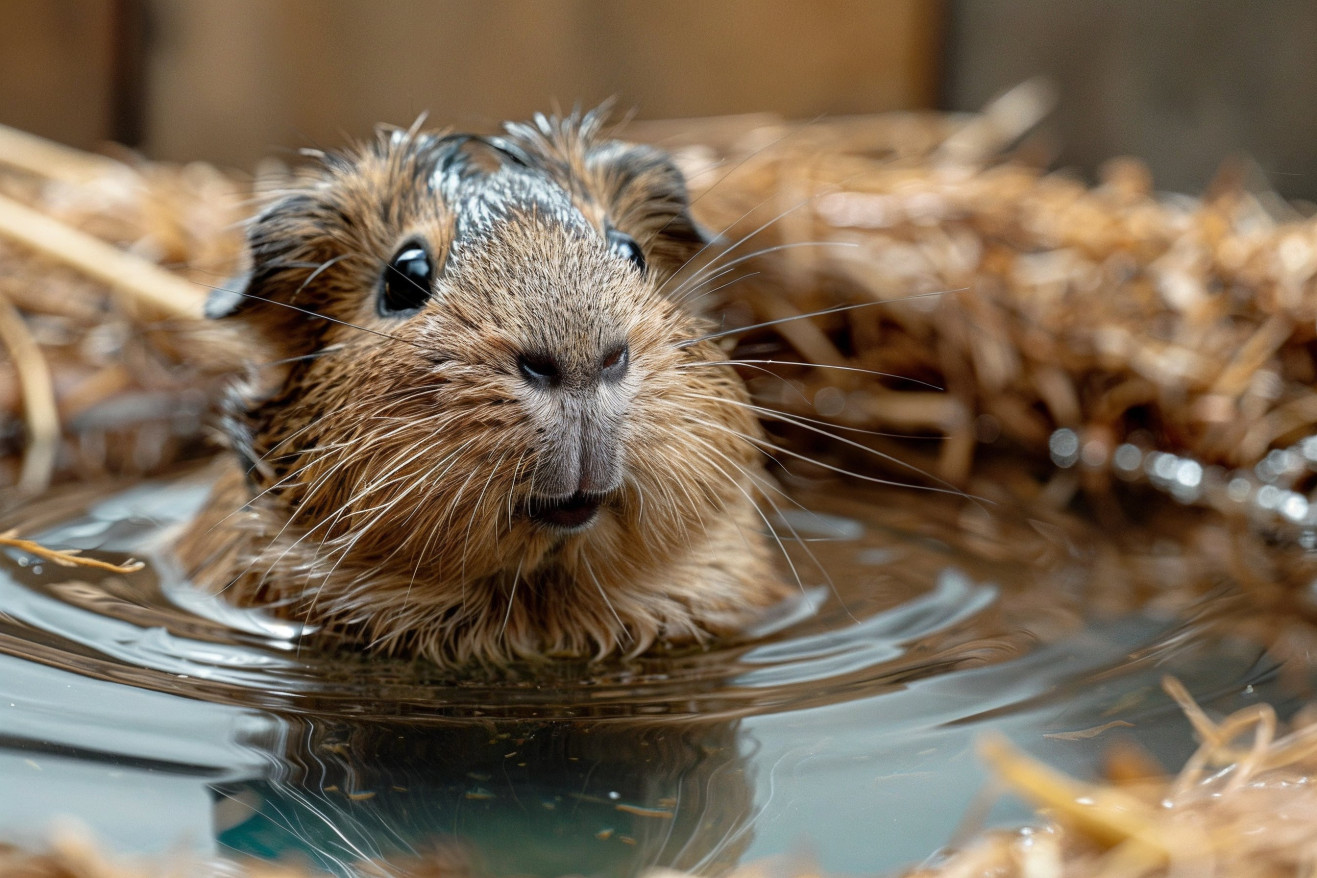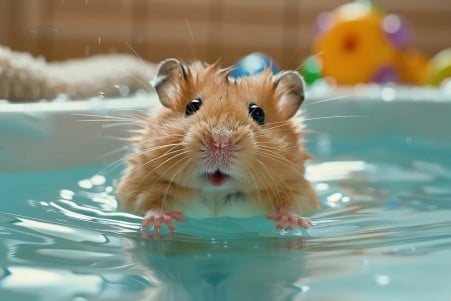Do Guinea Pigs Swim? The Truth About Their Ability to Take the Plunge
14 March 2024 • Updated 12 March 2024

It may be difficult to imagine, but have you ever wondered if guinea pigs can swim? While guinea pigs do have the ability to swim, it is extremely stressful for them and can even result in health problems, such as pneumonia. As a result, it is best to avoid situations that would require guinea pigs to swim in order to keep them safe and healthy.
This article will take a deep dive into veterinary research and ethological evidence to determine whether guinea pigs can swim. This investigation will look at anatomical evidence, behavioral research, and welfare concerns to provide a comprehensive look at this interesting question. By examining the larger topic of aquatic behavior in small mammals, this article will give readers the information they need to make sure their pets are safe and happy.
Do guinea pigs swim?
Why Guinea Pigs Can’t Swim
Guinea pigs have a unique body shape that is not conducive to swimming. According to the Merck Veterinary Manual, guinea pigs are stocky with short legs and a compact build, all of which make it difficult for them to swim effectively.
Their short legs in relation to other aquatic or semi-aquatic animals limit their ability to move through the water. As a result, guinea pigs have to work hard to swim and can quickly become exhausted.
Guinea pigs don’t swim in the wild. According to the Merck Veterinary Manual, guinea pigs don’t live in an environment that would require them to swim. The Andes Mountains in South America, where they are from, don’t have the kind of conditions that would make swimming a necessary survival skill.
In addition, as a study in PMC points out, guinea pigs are prone to stress and heat-related health problems like hyperthermia, which means that swimming them could be stressful and harmful and even result in health problems like respiratory distress.
Based on these observations, which are supported by the experts cited in the Merck Veterinary Manual, it is safe to say that guinea pigs don’t need to swim and that swimming can be detrimental to their health. When you also consider their physical limitations, it’s clear that guinea pigs should not be made to swim.
It’s important to recognize the risks to their health and the stress they may experience, which can have long-term health effects.
Stress from Swimming in Guinea Pigs
One of the most important reasons to understand the stress responses of guinea pigs is to understand how they react to swimming. According to a paper in PMC, the neuropeptide oxytocin is known to mediate stress responses in guinea pigs by decreasing cortisol levels—a stress hormone—in response to anxiety-provoking situations.
Swimming in guinea pigs has been shown to increase cortisol levels, and guinea pigs have also been shown to exhibit signs of stress, including vocalizations and a hunched posture, when swimming, which is a passive stress response.
Frontiers in Zoology reports that these stress responses can be suppressed in young guinea pigs by the presence of their mother or other familiar individuals, which shows how stressful these situations can be for guinea pigs when they are alone or in an unfamiliar environment.
The consequences of the stress of swimming in guinea pigs can be long-lasting. Chronic stress has been shown to lead to changes in behavior and immune function, according to the paper in PMC. Stress responses in guinea pigs can be detected by observing their behavior and measuring cortisol levels non-invasively, as a paper in PMC on physiological stress responses in guinea pigs explains.
When studying the effects of swimming on guinea pigs, researchers need to be mindful of the ethical implications of subjecting guinea pigs to an activity that is stressful and potentially harmful. By making sure that their welfare is a priority and avoiding activities that are stressful, such as swimming, owners can make sure that their pets are healthy and happy.
Aquatic Adaptations of Small Mammals: A Comparison with Guinea Pigs
Semiaquatic rodents have evolved a number of adaptations that allow them to thrive in aquatic environments, and many of these adaptations are quite different from those of guinea pigs.
For example, a study in the Journal of Mammalogy found that semiaquatic rodents like the American mink have evolved highly specialized diving abilities that are very different from those of guinea pigs, including adaptations like oxygen-conserving mechanisms and hydrodynamic body shapes that have evolved to support aquatic foraging, allowing these animals to dive to depths and durations that are well beyond what guinea pigs can achieve in the wild.
Another study in the Journal of Mammalogy found that some semiaquatic rodents like Nectomys species have evolved adaptations like lower water absorption rates in their fur and specialized swimming gaits that increase buoyancy and maneuverability. These adaptations have evolved in response to the specific evolutionary pressures and environmental conditions these rodents have faced, and they have enabled the animals to move efficiently between terrestrial and aquatic environments.
In contrast, guinea pigs have not evolved these adaptations because they have not faced the same evolutionary pressures and environmental conditions that would have made them necessary. While there may be some basic similarities in the way guinea pigs and semiaquatic rodents swim, the lack of these specialized adaptations in guinea pigs is a clear sign of evolutionary divergence.
Recognizing these differences can help researchers understand why guinea pigs don’t naturally seek out water as a habitat, and it can help guide future research into their natural behaviors and environmental requirements.
Guinea Pig’s Wild Ancestry
The guinea pig’s wild ancestors come from different parts of South America. As the Smithsonian’s National Zoo and Conservation Biology Institute notes, guinea pigs are indigenous to the Andes mountains, where they live at elevations of up to 14,000 feet. The Andes are characterized by their rugged terrain and harsh climate, and there are few bodies of water that would require swimming to survive.
As GuineaDad points out, the guinea pig’s tendency to freeze when threatened and their social nature, which includes living in herds, are behaviors that are seen in the wild. However, these behaviors are important for protecting guinea pigs from their natural predators and don’t involve swimming.
While guinea pigs have been domesticated for a long time and have adapted to a variety of living situations, they have not developed an instinct for swimming. It’s important for pet owners to know that guinea pigs’ natural habitat doesn’t include large bodies of water.
This helps explain why swimming isn’t an instinct for them and can help ensure that pet owners provide care that’s in line with their natural behaviors and helps keep them stress-free.
How to Take Care of Your Guinea Pig: Water and Health
Be sure to be careful when bathing your guinea pig to make sure that you are still maintaining their hygiene. GuineaDad suggests using shallow water, no more than an inch deep, and making sure that the water is warm enough to prevent stress and health issues like pneumonia.
Use a damp cloth or sponge to bathe your guinea pig to minimize water exposure, and then make sure to dry them off completely to prevent them from getting cold and sick.
Make sure that your guinea pig is comfortable and healthy by making sure that their environment is safe and stress-free. Since guinea pigs are prey animals, they like to have plenty of hiding spots in their environment where they can go to feel safe and secure. Make sure that their living space is free from loud noises and sudden movements to make sure that you aren’t causing them any stress.
While swimming is not recommended, guinea pigs can still enjoy water-related activities safely. For example, you can lightly mist your guinea pig on a hot day or use a damp cloth to wet their fur to help them cool down without the stress of being submerged in water.
Make sure to always be on the lookout for signs of stress in your guinea pig, which can include things like not moving, changes in eating habits, or strange noises. If you notice any of these signs or any other concerning behaviors or health problems, make sure to take your guinea pig to the vet as soon as possible to make sure that they are healthy and happy.
Conclusion: Guinea Pigs and Swimming
In conclusion, guinea pigs can swim, but it is not a natural behavior and is not good for them. GuineaDad stresses that even though guinea pigs can swim, swimming can lead to stress, health problems like pneumonia and ear infections, and even life-threatening situations like drowning and exhaustion. Their bodies are not built for swimming, so it is an unnatural and unnecessary activity for guinea pigs.
It is important for pet owners to know the natural behaviors and needs of guinea pigs so that they can take the best care of them.
Guinea pigs need to be in an environment that meets their needs for safety and comfort, and swimming is not part of that.
Pet owners need to make sure their guinea pigs are safe and happy because they are responsible for their well-being. In conclusion, it is important to keep in mind that the well-being of our guinea pig friends should be the most important thing and that means protecting them from stress and health problems that come from activities that are not natural to them.


